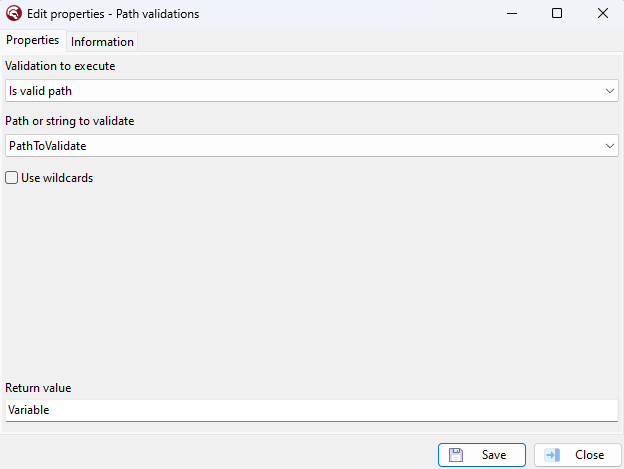Path validations can be used to check on different parts if a path valid
uses System.IOUtils.TPath Methods

Activity properties
begin var Variable: Boolean; try var FileNamePart := TPath.GetFileName(PathToValidate); var PathPart := TPath.GetDirectoryName(PathToValidate);
var IsValidFileName := TPath.HasValidFileNameChars(FileNamePart, False); var IsValidPathPart := TPath.HasValidPathChars(PathPart, False);
Variable := IsValidPathPart and IsValidFileName; except {$IF CompilerVersion > 34.0} on E: EInOutArgumentException do {$ELSE} on E: EArgumentException do {$ENDIF} Variable := False; end; end; |
Resulting code
The option "Use wild cards" will enable the wildcards (*) and (?) in the given path/filename value
Available methods
Has an extra string input for pattern
Returns True if the given value matches the specified pattern.
Example:
Path to validate = 'Project2024.fcp'.
Pattern to match = 'Project*.fcp'
begin var Variable: Boolean; Variable := TPath.MatchesPattern(PathToValidate, 'Project*.fcp', False); end; |
Result = False
Checks whether the drive letter used in the given path actually exists.
Example:
Path to validate = 'C:\Users\Username\Documents\Codolex\NonProject.fcp'.
begin var Variable: Boolean; Variable := TPath.DriveExists(PathToValidate); end; |
Result = False
Checks whether a given file name has an extension part.
Example:
Path to validate = 'C:\Users\Username\Documents\Codolex\Project.fcp'.
begin var Variable: Boolean; Variable := TPath.HasExtension(PathToValidate); end; |
Result = True
Checks whether a given file name contains only allowed characters.
Example:
Path to validate = 'C:\Users\Username\Documents\Codolex\Project.fcp'.
begin var Variable: Boolean; Variable := TPath.HasValidFileNameChars(PathToValidate, False); end; |
Result = False
Example:
Path to validate = 'C:\Users\Username\Documents\Codolex\Project.fcp'.
begin var Variable: Boolean; Variable := TPath.HasValidPathChars(PathToValidate, False); end; |
Result = True
Checks whether a given path is absolute and starts with a drive letter.
Example:
Path to validate = 'C:\Users\Username\Documents\Codolex\Project.fcp'.
begin var Variable: Boolean; Variable := TPath.IsDriveRooted(PathToValidate); end; |
Result = True
Checks whether a given path has an extended prefix. Extended meaning longer then the max path length of 260 chars.
Example:
Path to validate = 'C:\Users\Username\Documents\Codolex\Project.fcp'.
begin var Variable: Boolean; Variable := TPath.IsExtendedPrefixed(PathToValidate); end; |
Result = True
Checks whether a given path is an absolute path .
Example:
Path to validate = 'C:\Users\Username\Documents\Codolex\Project.fcp'.
begin var Variable: Boolean; Variable := TPath.IsPathRooted(PathToValidate); end; |
Result = True
Checks whether a given path is a relative path, in other words, not rooted to a drive.
Example:
Path to validate = 'C:\Users\Username\Documents\Codolex\Project.fcp'.
begin var Variable: Boolean; Variable := TPath.IsRelativePath(PathToValidate); end; |
Result = True
Checks whether a given path is in UNC (Universal Naming Convention) format.
Example:
Path to validate = 'C:\Users\Username\Documents\Codolex\Project.fcp'.
begin var Variable: Boolean; Variable := TPath.IsUNCPath(PathToValidate); end; |
Result = False
Checks whether the given path is UNC-rooted, where UNC stands for Universal Naming Convention.
Example:
Path to validate = 'C:\Users\Username\Documents\Codolex\Project.fcp'.
begin var Variable: Boolean; Variable := TPath.IsUNCRooted(PathToValidate); end; |
Result = False
Checks whether a given character is allowed in a file name.
Example:
String to validate = 'C'.
begin var Variable: Boolean; Variable := TPath.HasValidFileNameChars(PathToValidate[1]); end; |
Result = True
Checks whether a given character is allowed in a path string.
Example:
String to validate = 'C'.
begin var Variable: Boolean; Variable := TPath.HasValidPathChars(PathToValidate[1]); end; |
Result = True
Is valid path
Checks whether a given value name contains only allowed characters for file and path.
Uses Has valid filename chars and Has valid path chars
Is valid and existing path
Checks whether a given value name contains only allowed characters for file and path, and if the path actually exists.
Uses Has valid filename chars and Has valid path chars plus Directory exists or File exists